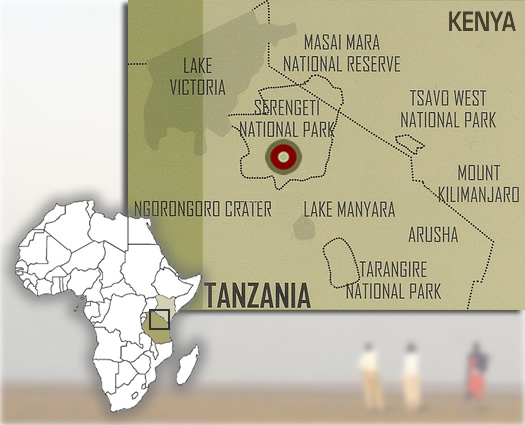Exclusive Mobile Camps - Location
DIRECTIONS
 The mobile camp has three different locations during the year according to the movement of the wildlife, allowing guests to be located close to the Migration.
The mobile camp has three different locations during the year according to the movement of the wildlife, allowing guests to be located close to the Migration.
From December to March the camp will be located in the southern plains, from June to July the camp will be located in the western corridor and from August to November in the north, offering guests the best possible experience of a traditional Mobile Classic Safari Camp. Nevertheless, the location is determined by the movements of the Migration.
BY AIR:
North charters companies flies to and from Arusha to different airstrips
in Serengeti on a daily basis, approximately 50 min flight. Also contects with
flights to and from Zanzibar and other national
parks.
BY ROAD:
Depending on the time of the allocation of the camp it takes approximately
5-10 hours, from Arusha.
Area Information
Serengeti National Park
Serengeti National Park is one of the largest wildlife sanctuaries which remain on the planet earth and the largest National Park of Tanzania. It covers an extension of 15,000 square kilometres. Its name comes from the language of the Masai which means "endless plains" and its landscapes depict the mythical image of an Africa of large spaces, profound blue skies dotted with clouds, cool sunrises and fire red sunsets.
Serengeti is situated on a high plateau which extends from east to west from the highlands of Ngorongoro to Lake Victoria and continues to the north to the Masai-Mara reserve in Kenya. The most outstanding characteristic of this gigantic ecosystem is the enormous concentration of herbivore, gnu, zebras, antelope, etc, on its plains and their annual migration. The gnu dominates in Serengeti and its herds are made up of hundreds of thousands.
At the end of the rains in April and May, around a million gnus and zebras congregate in the central plains of the Park and commence a spectacular migration which takes them towards Lake Victoria on the west and towards Masai Mara to the north, where fresh pastures await and permanent water during the dry season. This gigantic army in movement attracts the large predators, fundamentally lions and hyenas, being easy prey the young, old and sick.
Access to Serengeti from Ngorongoro takes us through a vast succession of herbaceous plains to Seronera Valley. Situated in the centre of the Park, the savannah, furrowed by the course of water and populated with acacias, is the ideal habitat for lions and leopards; it’s also easy to observe cheetahs in Seronera, where there is an abundance of prey amongst the countless gazelles which graze on the plains.
Towards the north, the landscape is more undulated and the open plain is substituted by open woods. It’s the kingdom of giraffes, impalas and elephants. To the west, towards the region of Lake Victoria, the "black cotton" plains stretch out, difficult to pass during the rainy season: Musabi, Ndabaka and Handajega and the Grumeti river with its famous giant crocodiles and its forests which are home to rare species such as the black and white colobo monkey as well as a multitude of birds.
Another rarity of Serengeti are the "Kopjes", genuine old granite islands of rock worn away by the erosion and set in a sea of grass. They possess an ecology of their own regarding vegetation and fauna. Where lizards, mongoose, monkeys, dik-diks, antelope and at the top of the food pyramid the Verreaux eagle and the leopard can often be seen.
Mention should be made of the large variety of birds which live in the
Park, more than 500 species have been registered, from enormous ostriches to
tiny
honey birds, a delight for any fan of ornithology.


